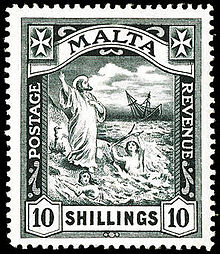
The Sovereign Military Order of Malta (SMOM), officially the Sovereign Military Hospitaller Order of Saint John of Jerusalem, of Rhodes and of Malta, commonly known as the Order of Malta, Malta Order or Knights of Malta, is a Catholic lay religious order, traditionally of a military, chivalric, and noble nature. Though it possesses no territory, the order is often considered a sovereign entity of international law, as it maintains diplomatic relations with many countries.

Victoria, also known among the native Maltese as Rabat or by its title Città Victoria, is an administrative unit of Malta, the largest and most prominent city of Gozo,. Victoria has a total population of 6,901, and by population, is the largest locality in Gozo.

Xewkija is an administrative unit of Malta, on the island of Gozo. The population of Xewkija is 3,300 as of March 2014.

Manuel Pinto da Fonseca was a Portuguese nobleman, the 68th Grand Master of the Order of Saint John, from 1741 until his death.

The Order of Knights of the Hospital of Saint John of Jerusalem, commonly known as the Knights Hospitaller, was a medieval and early modern Catholic military order. It was headquartered in the Kingdom of Jerusalem until 1291, on the island of Rhodes from 1310 until 1522, in Malta from 1530 until 1798 and at Saint Petersburg from 1799 until 1801. Today several organizations continue the Hospitaller tradition, specifically the mutually recognized orders of St. John, which are the Sovereign Military Order of Malta, the Most Venerable Order of the Hospital of Saint John, the Bailiwick of Brandenburg of the Chivalric Order of Saint John, the Order of Saint John in the Netherlands, and the Order of Saint John in Sweden.
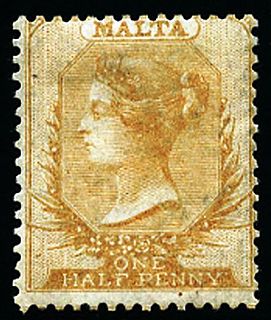
The postal history of Malta began in the early modern period, when pre-adhesive mail was delivered to foreign destinations by privately owned ships for a fee. The earliest known letter from Malta, sent during the rule of the Order of St John, is dated 1532. The first formal postal service on the islands was established by the Order in 1708, with the post office being located at the Casa del Commun Tesoro in Valletta. The first postal markings on mail appeared later on in the 18th century.
This page list topics related to Malta.

In the small Mediterranean island nation of Malta the predominant religion is Roman Catholicism.
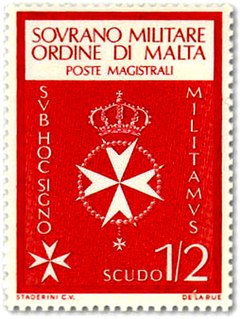
This is an article about the postage stamps and postal history of the Sovereign Military Order of Malta.
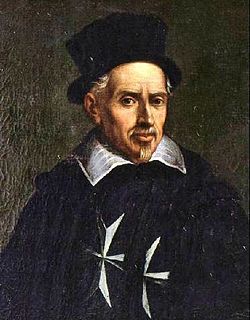
Giovanni Paolo Lascaris di Ventimiglia e Castellar was an Italian nobleman and Grand Master of the Knights of Malta.

The Halfpenny Yellow is the first postage stamp issued by the Crown Colony of Malta. Depicting Queen Victoria, it was only valid for local postage and it was originally issued on 1 December 1860. It was the only stamp issued by Malta for two and a half decades, and during this period various reprints were made with differences in colour shade, perforation and watermark. When control of Malta's postal service was transferred to the islands' colonial government on 1 January 1885, the stamp was withdrawn and it was replaced by a set of definitive stamps.

Hospitaller Malta, known within Maltese history as the Knights' Period, existed between 1530 and 1798 when the Mediterranean islands of Malta and Gozo were ruled by the Order of St. John of Jerusalem. The polity was formally a vassal state of the Kingdom of Sicily, and it came into being when Emperor Charles V granted the islands as well as the city of Tripoli in modern Libya to the Order, following the latter's loss of Rhodes in 1522. Hospitaller Tripoli was lost to the Ottoman Empire in 1551, but an Ottoman attempt to take Malta in 1565 failed.

The St Paul's Shipwreck 10/- black is a postage and revenue stamp issued by the Crown Colony of Malta on 6 March 1919, and it is generally considered to be the country's rarest and most expensive stamp. It is rare because a very limited quantity of 1530 stamps was printed and it was inadvertently issued prematurely by the Post Office.

The fortifications of Malta consist of a number of walled cities, citadels, forts, towers, batteries, redoubts, entrenchments and pillboxes. The fortifications were built over thousands of years, from around 1450 BC to the mid-20th century, and they are a result of the Maltese islands' strategic position and natural harbours, which have made them very desirable for various powers.
Saint Mary's Redoubt, also known as Migart Redoubt, was a redoubt on the island of Comino in Malta. It was built by the Order of Saint John in 1716 or 1761 as one of a series of coastal fortifications around the Maltese Islands.
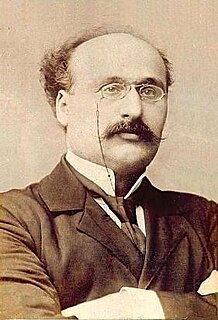
Paolino Vassallo was a Maltese composer.

Grand Master Philippe Villiers de l'Isle Adam Taking Possession of Mdina is a painting by the French artist Antoine de Favray from c. 1750. It depicts Philippe Villiers de L'Isle-Adam, a Grand Master of the Knights Hospitaller, entering the city of Mdina and taking possession of it in a ceremony known as the possesso. The real-life event which is the subject of the painting took place on 13 November 1530, shortly after the establishment of Hospitaller rule in Malta. The painting is an iconic representation of Hospitaller Malta, and it is located within the Grandmaster's Palace in Valletta, Malta.

The Corfiot Maltese are a population from the Greek island of Corfu (Kerkyra) with ethnic and religious ties to the islands of Malta. A large community of descendants of Maltese is still present in Corfu. In the case of the Maltese Corfiot, who lost knowledge of the Maltese language in favour of Greek in the first half of the 20th century, religious confession remained the strongest identity marker. Maltese Corfiots today make up 2/3 of the local Catholic community.
